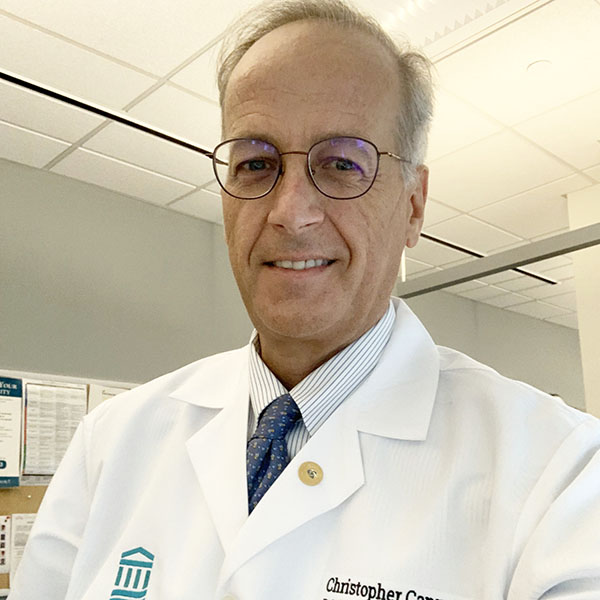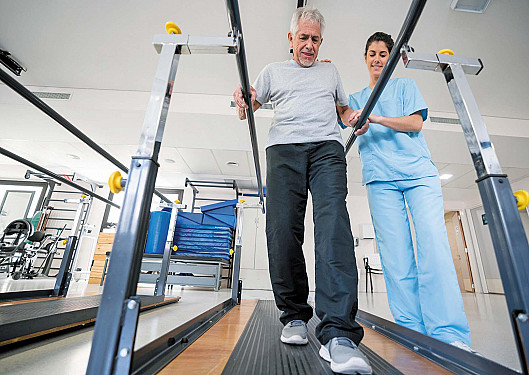When the doctor needs a new heart valve
A Harvard physician's experience with aortic stenosis — from the heart murmur first detected 10 years ago to his recent open-heart surgery.
- Reviewed by Christopher P. Cannon, MD, Editor in Chief, Harvard Heart Letter; Editorial Advisory Board Member, Harvard Health Publishing

About one in every 20 people over age 65 has a stiff, narrowed aortic valve. This hard-working valve regulates the flow of blood from the heart to the rest of the body. A decade ago, Dr. Howard LeWine, chief medical editor of Harvard Health Publishing, was diagnosed with aortic stenosis at the age of 66. Earlier this year, he underwent a surgical aortic valve replacement. Here's his story.
Q. How did you first learn you had aortic stenosis?
It was during a routine wellness check with my primary care physician. While listening to my heart, he heard a murmur and said, "You know, this sounds like aortic stenosis." Scar tissue and calcium deposits build up on the valve, which causes turbulent blood flow as the blood moves out of the heart into the body. It's known as a diamond-shaped murmur because the sound starts off soft, becomes louder, and then gets quiet again. After that, I had my first echocardiogram [an ultrasound of the heart], which showed that I had moderate aortic stenosis.
Like most people at that stage, I didn't have any symptoms. In fact, I was teaching spin classes three times a week and regularly getting my heart rate up above 150 beats per minute. It turns out that symptoms of aortic stenosis don't usually appear until the valve opening is so narrow that the blood flow to the body is dramatically reduced. That can cause chest pain; a fast, fluttering heartbeat; breathlessness; dizziness; and difficulty walking even short distances.
Q. How were you monitored after that?
My doctor referred me to a cardiologist. I originally had repeat echocardiograms every one to two years to check my valve, knowing that the narrowing in the valve opening progresses over time. I continued teaching spin classes without any symptoms.
A few years ago, I ran into a well-respected cardiologist I've known for a long time and asked him if there was anything I could do to stop the progression. The answer was no, although he did tell me that doctors often prescribe statins to people with aortic stenosis. It's not clear whether that makes any difference, but I was already taking a statin anyway to lower my LDL cholesterol, given my family history of early coronary artery disease.
Because of my desire to maintain a vigorous exercise routine, two years ago my cardiologist ordered a stress echocardiogram, which records images of your heart before and right after you exercise. This test is recommended for people without symptoms to check for changes in function of the left ventricle [the heart's main pumping chamber] during exercise, when the heart is working harder than usual. Although my ventricle was normal, the images showed an even smaller aortic valve opening than before. My cardiologist recommended more frequent monitoring, with an echocardiogram every six months.
My echocardiograms have also revealed an ascending aortic aneurysm, which is a bulge in the top section of the aorta, where it curves out of the heart [see "Raising awareness about aortic disease" in the May 2023 Heart Letter]. This condition is common in people with a bicuspid aortic valve, which means the valve has only two leaflets instead of the usual three. Bicuspid valves are also more likely to develop stenosis. Normally, an echocardiogram shows if you have a bicuspid valve, but mine never did. Later, before my surgery, a different imaging test revealed my bicuspid valve.
I recently decided to go ahead with surgery once my aortic stenosis was classified as severe, especially because of the added risk of a dissection or rupture of the aortic aneurysm.
Q. Was a nonsurgical treatment ever a consideration?
Yes. When I was first diagnosed, my cardiologist and I both hoped I'd be a candidate for TAVR, with is short for transcutaneous aortic valve replacement. [This procedure delivers a new valve to the heart through a catheter inserted through an artery at the top of the thigh; it doesn't require general anesthesia and has a faster, easier recovery than surgical valve replacement.] But once they discovered my aortic aneurysm, it made sense to replace the valve with open-heart surgery because the surgeon could repair the aneurysm during the same operation.
Another consideration was the orientation of my aortic valve, which was sitting in a somewhat horizontal position. That meant a TAVR could be more challenging to perform, as the interventional cardiologist I consulted explained to me. Finally, most of the trials to evaluate TAVR have included people with a tricuspid valve rather than a bicuspid valve, although I understand that's now starting to change.
Q. What other tests did you have prior to your surgery?
The test that confirmed I had a bicuspid valve was a CCTA [coronary computed tomography angiogram], a specialized x-ray that provides detailed, three-dimensional images of the heart and its blood vessels. But the original reason for this test was to check if I had any significant blockages in my coronary arteries, which could then be bypassed during my surgery. [A bypass uses a healthy vessel from the chest or leg to reroute blood around the narrowed artery.] Fortunately, my arteries were fine, so I didn't need that additional procedure. Both the valve replacement — which used a tissue valve from a cow — and the aneurysm repair went well.
Q. Do you have any advice for people with aortic stenosis?
Stick to the monitoring schedule your doctor recommends, which may help you avoid possible complications if your stenosis worsens more rapidly than expected. I really appreciated that my doctors made sure to replace my valve before I developed any left ventricle dysfunction, which can happen if your heart's working too hard. Before your procedure, get into the best possible physical shape you can and eat a healthy diet with plenty of protein, both of which may make for an easier recovery.
Q. A reader recently asked about exercising after a tissue valve replacement. Like you, he's an avid exerciser in his 70s. As he wrote: "Should I cut back on the intensity or duration of my exercise, knowing that the valve has only a finite number of cycles before it wears out?"
There's no good evidence that vigorous exercise might cause your new valve to wear out sooner, although it's theoretically possible. However, that won't deter me at all once I have completely recovered. Teaching spin classes and pushing myself physically is my jam.
Image: © Pitchayanan Kongkaew/Getty Images
About the Author

Julie Corliss, Executive Editor, Harvard Heart Letter
About the Reviewer

Christopher P. Cannon, MD, Editor in Chief, Harvard Heart Letter; Editorial Advisory Board Member, Harvard Health Publishing
Disclaimer:
As a service to our readers, Harvard Health Publishing provides access to our library of archived content. Please note the date of last review or update on all articles.
No content on this site, regardless of date, should ever be used as a substitute for direct medical advice from your doctor or other qualified clinician.
















